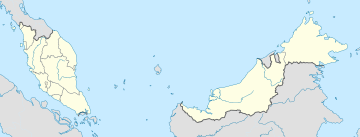Sri Aman
| Sri Aman | ||
|---|---|---|
|
||
| Location in Malaysia | ||
| Coordinates: 1°14′7″N 111°28′11″E / 1.23528°N 111.46972°E | ||
| Division Office Location | Sri Aman | |
| Local area government(s) | Majlis Daerah Sri Aman | |
| Population (2015) | ||
| • Total | 102,092 | |
| Postal code | 95xxx | |
| International dialling code prefix | +6083 (landline only) | |
| Wali Kota (Council Chairman) | En. Piau ak Inggot | |
| Nickname | The Benak Town | |
| Website | Sri Aman: www.sriamandc.sarawak.gov.my | |
Sri Aman is a market town and port, and the capital of Sri Aman District and Sri Aman Division in Sarawak, east Malaysia.
Sri Aman is also called Bandar Sri Aman, and was formerly known as Simanggang. Sri Aman means "town of peace" in the Malay language. Located on the Lupar River, it is 193 kilometers, a three-hour drive, from Kuching, the capital of Sarawak. It is a trade center for the timber, oil palm, rubber, and pepper of its mostly agricultural district.
Sri Aman is famous for the benak, or tidal bore, of the Batang Lupar River. The tidal bore comes in from the river mouth and fills up the river very rapidly in the course of about 10 minutes. The wave crest at Sri Aman is up to 2 to 3 metres high. This is one of approximately 48 rivers and estuaries in the world where this phenomenon happens. What is special about Sri Aman's benak is that it occurs everyday, the only river in the world that does that.
There is a timetable at the river which has the time and dates for when the tidal bore will occur, but the really big ones occur only a couple of times a year. The author Somerset Maugham almost died at Simanggang during one of these tidal bores, and commemorated the event in his short story Yellow Streak.
Sri Aman is also a gateway for tourists to the Batang Ai National Park, and cultural tours to the Iban longhouses along the rivers.
Fort Alice, built in 1864, is the oldest heritage building in Sri Aman, constructed following the victory of Rajah Charles Brooke, the second Rajah of Sarawak, over Rentap, the last of the major Iban chieftains, in 186. The Fort was named after Charles Brooke's wife, Margaret Alice Lili de Windt. It served as a defensive structure controlling the Lupar River.
...
Wikipedia


